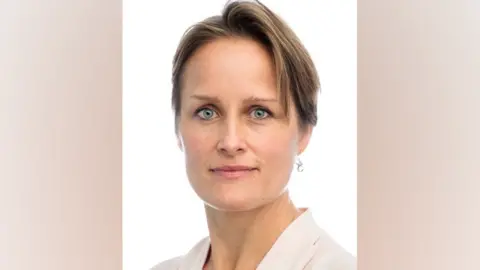MI6 appoints first female chief in 116-year history
 UK Foreign Office/AP
UK Foreign Office/APMI6 will be led by a woman for the first time in the foreign intelligence service's 116-year history.
Blaise Metreweli, who joined the Secret Intelligence Service in 1999, will become the 18th chief of the organisation and take over from Sir Richard Moore later this year.
She is currently responsible for technology and innovation at the service and said she was "proud and honoured" to have been asked to lead.
Prime Minister Sir Keir Starmer called the appointment "historic" at a time "when the work of our intelligence services has never been more vital".
MI6 is tasked with gathering intelligence overseas to improve the UK's security, with its core aims being to stop terrorism, disrupt the activities of hostile states and bolster cyber-security.
Its chief, commonly referred to as "C", is the only publicly named member of the service.
Ms Metreweli, 47, is currently Director General "Q" - head of the crucial technology and innovation division that aims to keep the identities of secret agents secret, and come up with new ways to evade adversaries like China's biometric surveillance.
"MI6 plays a vital role - with MI5 and GCHQ - in keeping the British people safe and promoting UK interests overseas," she said.
"I look forward to continuing that work alongside the brave officers and agents of MI6 and our many international partners."
Ms Metreweli, who studied anthropology at the University of Cambridge, has previously held director level roles in MI5 - MI6's sister, domestic security agency - and spent most of her career working in the Middle East and Europe.
On the King's overseas and international birthday honours list in 2024, she received the Companion of the Order of St Michael and St George (CMG) for her services to British foreign policy.
Speaking to the Telegraph in December 2021 when she was at MI5, under the pseudonym of "Director K", Ms Metreweli said threats to UK national security "really are diverse".
"The threats we are looking at primarily exist around protecting government, protecting secrets, protecting our people - so counter-assassination - protecting our economy, sensitive technology and critical knowledge," she said.
She added that "Russian state activity - not Russia itself - remains a threat" and that China was "changing the way the world is and that presents amazing opportunities and threats for the UK".
What does 'C' do?
- C is the head of MI6, officially known as Secret Intelligence Service, and they report to the foreign secretary.
- C is also part of the Joint Intelligence Committee, alongside heads of other departments and senior government officials. It receives intelligence reports, analyses ongoing situations and advises the prime minister
- It is a common misnomer to think that the "C" stands for Chief. It does not. Britain's very first spy agency was called the Secret Service Bureau, established in the 1900s. It was led by a Royal Navy officer, Captain Mansfield Cumming. He always signed his letters "C" and the codename has stuck.
- Captain Cumming wrote in green ink. To this day, the head of MI6 is the only person in Whitehall who will write in green.
- And does C give his or her agents a "licence to kill"? No. But the foreign secretary can. Under Section 7 of the Intelligence Services Act 1994, an MI6 agent can be authorised to carry out certain actions which would otherwise be illegal - including using lethal force. But it is a long and complicated legal process.
The organisation she will be running faces unprecedented and multiple challenges.
Geographically, these emanate primarily from Russia, China, Iran and North Korea, as the four nations co-operate ever more closely to undermine UK and Western interests across the globe.
But there are technical challenges too.
MI6's role is to recruit human agents to steal secrets from Britain's adversaries, which include both hostile nations and non-state groups like al-Qaeda.
In an age of rapid digital innovation, MI6 is having to pedal ever faster to stay ahead of its enemies and to remain relevant, when so much intelligence is now gathered online and from space.
Last September, outgoing chief Sir Richard - alongside then-CIA chief William Burns - warned that the international world was "under threat in a way we haven't seen since the Cold War".
Writing in the Financial Times, the pair said that beyond the war in Ukraine, the two foreign intelligence services were continuing to "work together to disrupt the reckless campaign of sabotage across Europe being waged by Russian intelligence".
Sir Richard and Mr Burns added that they saw the rise of China as the main intelligence and geopolitical challenge of the century. They also said they had pushed "hard" for restraint and de-escalation in the Middle East.
On Sunday, Sir Richard, who will step down in the autumn after five years in the role, said he was "absolutely delighted" with the "historic appointment" of his colleague.
"Blaise is a highly accomplished intelligence officer and leader, and one of our foremost thinkers on technology," he said.
"I am excited to welcome her as the first female head of MI6."
Foreign Secretary David Lammy, to whom Ms Metreweli will be accountable as MI6's new chief, said she was the "ideal" candidate and would ensure the UK was able to tackle the challenges of "global instability and emerging security threats".
"I would also like to pay tribute to Sir Richard Moore for his service and leadership," he said.
"I have worked closely with him over the past year and thank him for his valuable contribution enhancing our national security and protecting the British public."
Sir Keir also thanked Sir Richard for his "dedicated service".
"I know Blaise will continue to provide the excellent leadership needed to defend our county and keep our people safe," he added.
Additional reporting by Hollie Cole

Get our flagship newsletter with all the headlines you need to start the day. Sign up here.
